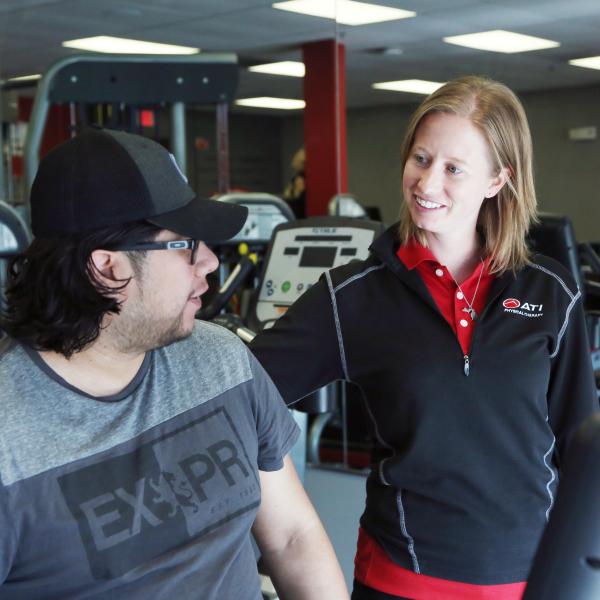The Benefits of Physical Therapy for Stroke Patients

By: Denise Lovorn, PT, DPT, CSRS
We all might have heard of the signs and symptoms; facial numbness, arm weakness, slurring of speech. These are all symptoms one might experience while having a stroke. But what exactly is a stroke? What should you or your family member expect after this happens?
What is a Stroke?
According to the National Stroke Association, a stroke is a “brain attack” and happens to nearly 800,000 individuals each year. In fact, it is currently the fifth leading cause of death in the U.S. A stroke occurs when the blood flow to an area of the brain is cut off, depriving the brain cells of oxygen which causes cell death. This can be caused by a clot traveling into the arteries that supply the brain in what is called an ischemic stroke, or when a hemorrhagic event occurs such as a fall or a blow to the head. When the brain cells die, the abilities controlled by that area of the brain such as memory, speech, motor control, sensation, vision and coordination are impaired.
Common Signs and Symptoms of a Stroke
The symptoms of the stroke are dependent on the areas damaged, which is why a person with a minor stroke may only have temporary arm weakness or leg weakness, and others may have a more permanent paralyzing condition leaving them with the inability to speak or the inability to move one side of their body (hemiparesis). If someone you know has a stroke, the American Stroke Association recommends seeking medical attention with three hours. Immediate treatment has shown to dramatically reduce the long-term effects of a stroke and even prevent death.
How Does Therapy Work For a Stroke?
While the treatment for stroke is a collaborative effort between disciplines, the research is consistent in recommending early intervention for stroke rehabilitation as being most effective for recovery. Rehabilitation starts when the person is still in the hospital. From the hospital setting, a person who has suffered a stroke may go to a rehabilitation hospital or skilled nursing facility, if the impairments are such that the person cannot return home yet safely. After discharge, the patient will typically enter therapy in home health or outpatient physical therapy.
Long-Term Effects of a Stroke
As a provider in the outpatient setting treating persons who have had a stroke, our interventions are focused on retraining the brain with the principles of neuroplasticity. While research continues, it is our current understanding that our brains are in fact not hardwired, but they are constantly evolving to the functional and environmental demand placed on it. Because of this, when one area of the brain is damaged, the cells surrounding this area change their function to take on the jobs of the damaged cells. This process is most active and effective early on in recovery, but can occur up to years following a stroke allowing for continued improvement in a person’s function.
Recovering Neuroplasticity After a Stroke
The keys to training using neuroplasticity are based on ten principles:
- Use It or Lose It: Failure to drive specific brain functions can lead to functional degradation. In other words, we must work to activate areas of the brain or risk losing that function.
- Use It and Improve It: Training that drives a specific brain function can lead to an enhancement of that function.
- Specificity: The nature of the training dictates the nature of the plasticity. If the patient wants to improve on walking, then they must practice that specific activity.
- Repetition Matters: Sufficient repetition is required for plasticity. There is no magic number of repetitions required, but it is agreed upon that it is a lot of repetition.
- Intensity Matters: The intensity must be enough to produce a lasting change. In other words, your therapist shouldn’t be “taking it easy” on you. Recovery requires hard work.
- Time Matters: The training must occur over a length of time.
- Salience Matters: This taps into motivation, the training must be salient enough to effect change. If it is not an activity the client performs or is unimportant, it is likely this activity won’t produce change.
- Age Matters: Younger brains are more plastic.
- Transference: Plasticity produced by one type of training experience can lead to the acquisition of other behaviors.
- Interference: Plasticity in response to one experience can interfere with the acquisition of other behaviors.
The Benefits of Physical Therapy for Stroke Patients
Keeping these principles in mind, the emphasis is always on function for rehabilitation after a stroke. Typically, when a client comes for therapy following a stroke, recovering their ability to walk normally is an important goal for the client. While this is typically an area focus of therapy, PT after stroke is so much more than that! Your therapist will work on bed mobility, transfers, balance, coordination, lifting, pushing, pulling, reaching, floor transfers, stair climbing, fall recovery, return to work/vocation and other functional activities to help achieve your goals. They will also advise on any modifications, equipment or prosthetic/orthotics such as braces that may be appropriate to aid in your recovery. Lastly, they can help to address other issues like pain, joint stiffness, spasticity and sensation deficits. Working with a provider, like ATI, that is experienced in caring for individuals with neurologic disorders or injuries will help to address the specific issues related to the diagnosis of stroke.
Stop by your nearest ATI Physical Therapy clinic for a complimentary screening and get back to doing you. Our experts will listen to your concerns, evaluate your injury and create a safe and effective plan to help you reach your goals and live a healthy, active lifestyle.
